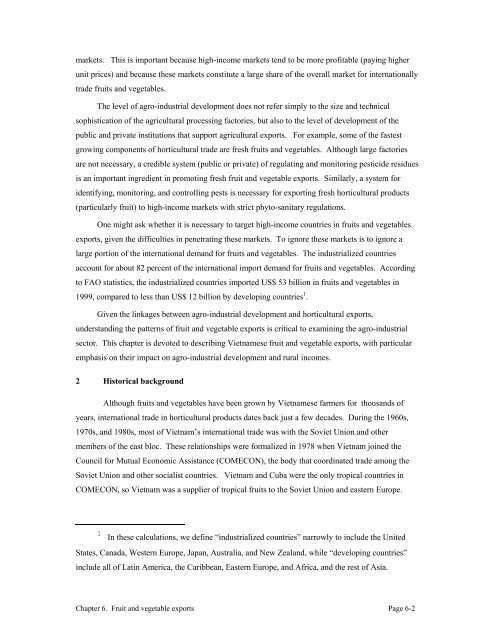Fruits and Vegetables in Vietnam - International Food Policy ...
Fruits and Vegetables in Vietnam - International Food Policy ...
Fruits and Vegetables in Vietnam - International Food Policy ...
You also want an ePaper? Increase the reach of your titles
YUMPU automatically turns print PDFs into web optimized ePapers that Google loves.
markets. This is important because high-<strong>in</strong>come markets tend to be more profitable (pay<strong>in</strong>g higher<br />
unit prices) <strong>and</strong> because these markets constitute a large share of the overall market for <strong>in</strong>ternationally<br />
trade fruits <strong>and</strong> vegetables.<br />
The level of agro-<strong>in</strong>dustrial development does not refer simply to the size <strong>and</strong> technical<br />
sophistication of the agricultural process<strong>in</strong>g factories, but also to the level of development of the<br />
public <strong>and</strong> private <strong>in</strong>stitutions that support agricultural exports. For example, some of the fastest<br />
grow<strong>in</strong>g components of horticultural trade are fresh fruits <strong>and</strong> vegetables. Although large factories<br />
are not necessary, a credible system (public or private) of regulat<strong>in</strong>g <strong>and</strong> monitor<strong>in</strong>g pesticide residues<br />
is an important <strong>in</strong>gredient <strong>in</strong> promot<strong>in</strong>g fresh fruit <strong>and</strong> vegetable exports. Similarly, a system for<br />
identify<strong>in</strong>g, monitor<strong>in</strong>g, <strong>and</strong> controll<strong>in</strong>g pests is necessary for export<strong>in</strong>g fresh horticultural products<br />
(particularly fruit) to high-<strong>in</strong>come markets with strict phyto-sanitary regulations.<br />
One might ask whether it is necessary to target high-<strong>in</strong>come countries <strong>in</strong> fruits <strong>and</strong> vegetables<br />
exports, given the difficulties <strong>in</strong> penetrat<strong>in</strong>g these markets. To ignore these markets is to ignore a<br />
large portion of the <strong>in</strong>ternational dem<strong>and</strong> for fruits <strong>and</strong> vegetables. The <strong>in</strong>dustrialized countries<br />
account for about 82 percent of the <strong>in</strong>ternational import dem<strong>and</strong> for fruits <strong>and</strong> vegetables. Accord<strong>in</strong>g<br />
to FAO statistics, the <strong>in</strong>dustrialized countries imported US$ 53 billion <strong>in</strong> fruits <strong>and</strong> vegetables <strong>in</strong><br />
1999, compared to less than US$ 12 billion by develop<strong>in</strong>g countries 1 .<br />
Given the l<strong>in</strong>kages between agro-<strong>in</strong>dustrial development <strong>and</strong> horticultural exports,<br />
underst<strong>and</strong><strong>in</strong>g the patterns of fruit <strong>and</strong> vegetable exports is critical to exam<strong>in</strong><strong>in</strong>g the agro-<strong>in</strong>dustrial<br />
sector. This chapter is devoted to describ<strong>in</strong>g <strong>Vietnam</strong>ese fruit <strong>and</strong> vegetable exports, with particular<br />
emphasis on their impact on agro-<strong>in</strong>dustrial development <strong>and</strong> rural <strong>in</strong>comes.<br />
2 Historical background<br />
Although fruits <strong>and</strong> vegetables have been grown by <strong>Vietnam</strong>ese farmers for thous<strong>and</strong>s of<br />
years, <strong>in</strong>ternational trade <strong>in</strong> horticultural products dates back just a few decades. Dur<strong>in</strong>g the 1960s,<br />
1970s, <strong>and</strong> 1980s, most of <strong>Vietnam</strong>’s <strong>in</strong>ternational trade was with the Soviet Union <strong>and</strong> other<br />
members of the east bloc. These relationships were formalized <strong>in</strong> 1978 when <strong>Vietnam</strong> jo<strong>in</strong>ed the<br />
Council for Mutual Economic Assistance (COMECON), the body that coord<strong>in</strong>ated trade among the<br />
Soviet Union <strong>and</strong> other socialist countries. <strong>Vietnam</strong> <strong>and</strong> Cuba were the only tropical countries <strong>in</strong><br />
COMECON, so <strong>Vietnam</strong> was a supplier of tropical fruits to the Soviet Union <strong>and</strong> eastern Europe.<br />
1 In these calculations, we def<strong>in</strong>e “<strong>in</strong>dustrialized countries” narrowly to <strong>in</strong>clude the United<br />
States, Canada, Western Europe, Japan, Australia, <strong>and</strong> New Zeal<strong>and</strong>, while “develop<strong>in</strong>g countries”<br />
<strong>in</strong>clude all of Lat<strong>in</strong> America, the Caribbean, Eastern Europe, <strong>and</strong> Africa, <strong>and</strong> the rest of Asia.<br />
Chapter 6. Fruit <strong>and</strong> vegetable exports Page 6-2
















